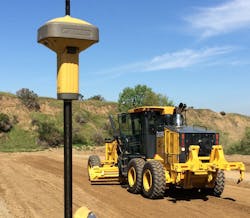For all the good things telematics data can do for asset management, such as maintaining machine health and helping an operation’s bottom line, there are also safety aspects that a savvy manager shouldn’t overlook—and they’re not exclusively for an on-road fleet.
The safety experts at Vista Training, a Wis.-based provider of training solutions for the earthmoving, excavating and mining industries, point to a number of key safety benefits of telematics that may not be top-of-mind.
Monitor, correct unsafe practices
Sensors in the equipment can detect when, and how often, operators are not only speeding, but also doing heavy braking, driving without lights at night, or other unsafe behaviors.
These problems aren’t limited to pickups and on-road haulers: Think about ADTs navigating haul roads, where excessive braking can lead to unnecessary wear and subsequent diminished braking, or wheel loader, grader and backhoe operators that need to see—and be seen—while traversing large, spread-out job sites or long, linear highway jobs.
Warnings based on operator behaviors can be set to go directly to the manager or fleet owner to initiate corrective action. This can lead to increased awareness among the operators themselves, or better training to improve operation and lengthen asset life. It also may lead to a few difficult conversations with operators, but once again, telematics can help.
Hard evidence
Watching operators operate equipment in an unsafe manner and simply pointing out the unsafe behaviors in a conversation may not always yield the desired result. Operators can claim the manager is being subjective, or argue about their performance.
Telematics can provide objective data that can be used to justify the need to change unsafe habits.
Unauthorized use
Along with theft, unauthorized or personal use of equipment is a big concern for managers. Consider the liability exposure of a worker taking a skid steer home on a weekend for a personal landscaping or driveway project.
What if the operator backs over the child from next door? It may sound farfetched, but managers have to be wary of all possible scenarios.
Even the most basic telematics package lets owners set up a geofence, a strict area in which the equipment must operate. If the equipment leaves that area, an alert is generated. There’s also the possibility of a “time fence,” starting and ending times outside of which the machine should not be operated.
A time fence can play a part in preventing unauthorized use, of course, but it’s also a means to check productivity—is there a problem with the job during the day that is causing an operator to try to run his machine after previously set job-site hours?
Traffic management
Job sites in congested areas and urban settings often have traffic management plans to keep equipment separated from traffic. In the event an unauthorized vehicle turns into an area where it doesn’t belong, telematics has the capability to alert all the nearby equipment operators, potentially avoiding an accident.
Documentation
Finally, if there is an accident, there’s a tangible documentation benefit. A little bit like the black box on an airplane, telematics data can be helpful in determining what an operator was doing before the accident. The data will show whether the operator was operating within normal parameters at the time, which can help corroborate, or disprove, a version of events from a witness or participant.





